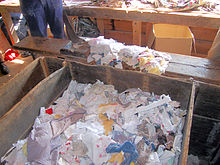Struggle (textile)

Photograph by Eugène Atget , 1899
Hader , derived from the Old High German word hadara ("sheep's clothing"), is the Middle High German name for a piece of cloth that has been torn off or cut off , also called rags or scraps . A struggle is also a worn, tattered piece of clothing that falls apart due to age.
Hader as a fiber raw material in paper production
Until the middle of the 19th century, rags made of linen , hemp or cotton - together with spinning and rope mill waste - were the only available fiber raw material for the production of paper, the so-called rag paper .
From the Middle Ages into the 20th century, wandering rag collectors, as traveling people, collected or bought these textiles from the population and sold them to paper mills . The papermakers often attached great importance to the fact that the sovereign rulers granted them special rights to acquire rag. The introduction of chemical bleaching (use of chlorine gas , chlorinated lime, etc.) enabled the raw material base of fine paper mills to be expanded in the course of the 19th century.
Today's use for the production of high quality papers
Today, less than 2% of the fiber raw materials used in paper manufacture are obtained from rag. They are torn or shredded in a "rag cutter" or "rag thresher" so that the fibers remain as undamaged as possible. Textile lumps - today the generic term for unwooded plant fibers from z. B. Cotton or linen - because of their long-chain fibers, they are the best raw material for paper production. Papers made from rag or with a proportion of rag are more resistant to aging and more robust than paper made from cellulose. The basis for these papers are the fibers obtained from rags, which are mixed with cellulose , pure fiber additives (e.g. pure cotton) and, increasingly, with man-made fibers . These are used for papers with special requirements.
See also
literature
- Wilhelm Heinrich v. Kurrer: About bleaching linen rags to make white paper. In: Negotiations of the association for the promotion of industry in Prussia. Vol. 9, 1830, pp. 155-163.
- E. Bourdilliat: The discoloration and bleaching of the rags. With the assistance of L. Keferstein in Cröllwitz, translated into German by N. Gräger, BF Voigt, Weimar 1867.
- Julius Post: rag and paper calculations. According to practical results. With glued in rag u. Paper patterns. Koenigstein i. Saxony 1875.
- Strife 2, a). In: Jacob Grimm , Wilhelm Grimm (Hrsg.): German dictionary . tape 10 : H, I, J - (IV, 2nd division). S. Hirzel, Leipzig 1877, Sp. 111–112 ( woerterbuchnetz.de ).
- Hermann Stern: The historical development and current situation of the rag trade in Germany. Erlangen, Phil. Diss. 1914. Hanover, 1914, OCLC 459062094 .
Web links
- "Textile recycling" on the website of the Federal Association of Secondary Raw Materials and Disposal
